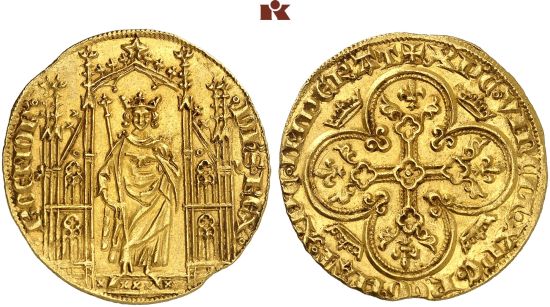Difference between revisions of "Luxembourg (1337) royal d'or Fr-2"
(Created page with "550px|thumb|Künker sale 400, lot 686 This specimen was lot 686 in Künker sale 400 (Berlin, February 2024), where it sold for €150,000 (about US$1...") |
m (Text replacement - "Delm. " to "Delm-") |
||
| Line 8: | Line 8: | ||
''Specification:'' 4.21 g, gold, this specimen 4.18 g. | ''Specification:'' 4.21 g, gold, this specimen 4.18 g. | ||
| − | ''Catalog reference:'' Fr-2 ("Very rare"); Weiller 54; Delm | + | ''Catalog reference:'' Fr-2 ("Very rare"); Weiller 54; Delm-385 (R3); Probst L 61-1; Vanhoudt Atlas G 1423. |
''[[Bibliography|Source:]]'' | ''[[Bibliography|Source:]]'' | ||
Latest revision as of 11:55, 11 December 2024
This specimen was lot 686 in Künker sale 400 (Berlin, February 2024), where it sold for €150,000 (about US$194,595 including buyer's fees). The catalog description[1] noted,
"TSCHECHIEN, BÖHMEN - MÄHREN, Johann von Luxemburg, 1310-1346. Royal d'or o. J. (1337), geprägt für die Grafschaft Luxemburg. ° IOhÆ S ° ReX ° - ° BOeMORÆ ° Der König steht v. v. mit langem Zepter in der Rechten unter gothischem Portal//+ XPÆC ° VInCIT · XPÆC ° ReG ° HaT ° XPÆC ° IMPeRaT Blumenkreuz mit je einer Lilie an den Enden, umher Vierpaß in den äußeren Winkeln je eine Krone. GOLD. Von allergrößter Seltenheit. Einziges im Handel befindliche Exemplar. Prachtexemplar. Feiner Prägeglanz, vorzüglich. (Czechia, Bohemia-Moravia, John of Luxembourg, 1310-46, undated royal d'or, circa 1337, struck for the couty of Luxembourg. Obverse: the king stands with long scepter under a Gothic dais; reverse: floriate cross cantonned with crowns in the quatrefoil. Supremely rare, the only one in private hands, choice example, fine luster, extremely fine.)
Johann von Luxemburg wurde 1296 als Sohn des späteren Kaisers Heinrich VII. und Margaretes von Brabant geboren. Mit zwölf Jahren wurde er bereits von seinem Vater 1308 als neu gewählten römisch-deutscher König mit der Grafschaft Luxemburg belehnt. 1310 heiratete er 14jährig die böhmische Prinzessin Elisabeth, die letzte Überlebende der Premyliden-Dynastie. Im Oktober des Jahres 1310 zog er mit Vertrauten nach Böhmen, während sein Vater nach Italien aufbrach, um die Kaiserkrone zu erlangen. Johann versuchte die Eroberung von Kuttenberg und weiteren Städten, alle zunächst erfolglos. Bei seiner Wahl zum böhmischen König 1311 mußte er den böhmischen Adligen weit entgegenkommen. Danach mischte er in ganz Europa mit, so in den Kreuzzügen des Deutschen Ordens gegen die Litauer, in Schlesien, in Frankreich und in Italien. 1332 verpflichtete Johann sich vertraglich zur Unterstützung Frankreichs – außer gegen den römisch-deutschen König. Der große Turnierheld mußte 1337 die Erblindung des rechten Auges hinnehmen, die eine Erbkrankheit im Haus Luxemburg darstellte, später erblindete er zudem auch auf dem linken Auge. Trotz Erblindung unterstützte er die Franzosen in den Kampfhandlungen gegen England (Hundertjähriger Krieg), teils sogar mit Erfolg. Den Tod fand er 1346 in der Schlacht von Crécy, als er völlig erblindet ins Kampfgetümmel ritt und erschlagen wurde. Diese ritterliche Bündnistreue beindruckte den europäischen Adel stark, Johann der Blinde ist bis heute Nationalheld der Luxemburger. In seiner Grafschaft Luxemburg war er verantwortlich für eine vielfältige Münzserie, die sich Vorbilder aus den Nachbarregionen suchte, so Brabant, England oder auch Frankreich, wie auf dem vorliegenden, äußerst seltenen Exemplar, welches im Stil des französischen Royal d'or geprägt wurde. (John of Luxembourg was born in 1296 as the son of the future Emperor Henry VII and Margaret of Brabant. At the age of twelve, he was enfeoffed with the County of Luxembourg by his father in 1308 as the newly elected Roman-German king. In 1310, at the age of 14, he married the Bohemian Princess Elisabeth, the last survivor of the Premyslid dynasty. In October 1310 he moved to Bohemia with his suite while his father set off for Italy to obtain the imperial crown. Johann tried to conquer Kutná Hora and other cities, all initially unsuccessfully. When he was elected King of Bohemia in 1311, he had to go a long way towards accommodating the Bohemian nobles. Afterwards he was involved throughout Europe, for example in the Teutonic Order's crusades against the Lithuanians, in Silesia, in France and in Italy. In 1332, John made a contractual commitment to support France - except against the Roman-German king. In 1337, the great tournament hero suffered blindness in his right eye, which was a hereditary disease in the House of Luxembourg, and later he also became blind in his left eye. Despite his blindness, he supported the French in the fighting against England (Hundred Years' War), sometimes even with success. He died in the Battle of Crécy in 1346, when he rode completely blind into the fray and was killed. This knightly loyalty to the alliance greatly impressed the European nobility; John the Blind is still a national hero of the Luxembourgers today. In his county of Luxembourg, he was responsible for a diverse series of coins that sought models from neighboring regions, such as Brabant, England and France, as in the present, extremely rare example, which was minted in the style of the French Royal d'or.)"
Recorded mintage: unknown.
Specification: 4.21 g, gold, this specimen 4.18 g.
Catalog reference: Fr-2 ("Very rare"); Weiller 54; Delm-385 (R3); Probst L 61-1; Vanhoudt Atlas G 1423.
- Friedberg, Arthur L. and Ira S. Friedberg, Gold Coins of the World, From Ancient Times to the Present, 9th ed., Clifton, NJ: Coin and Currency Institute, 2017.
- [1]Künker, Fritz Rudolf, Horst-Rudiger Künker, Ulrich Künker and Andreas Kaiser, Katalog 400: Selected löser of the Dukes of Guelph from the Friedrich Popken Collection | Numismatic treasures from the Medieval and Modern Times, a. o. "multiple portraits" from a Westphalian private collection, Osnabrück: Fritz Rudolf Künker GmbH & Co., AG, 2024.
Link to:
